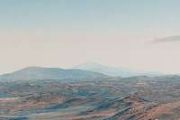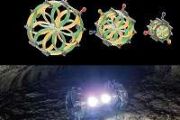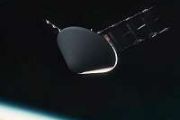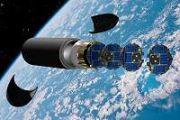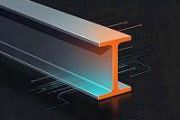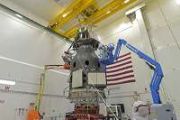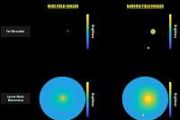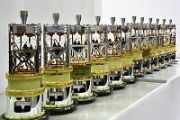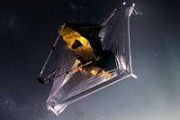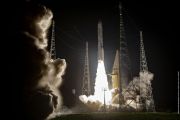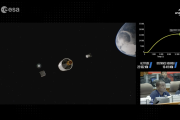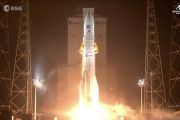
Copernical Team
A new clue to how multicellular life may have evolved
 Life began on Earth around 3.8 billion years ago, with organic molecules forming in watery environments under the influence of sunlight and electrical activity, according to the widely held primordial soup theory. These early chemical reactions, likely powered by RNA, ultimately led to the emergence of single-celled organisms.
But what catalyzed the leap from single-celled organisms to com
Life began on Earth around 3.8 billion years ago, with organic molecules forming in watery environments under the influence of sunlight and electrical activity, according to the widely held primordial soup theory. These early chemical reactions, likely powered by RNA, ultimately led to the emergence of single-celled organisms.
But what catalyzed the leap from single-celled organisms to com Sound waves reveal secrets of stellar evolution and galactic history
 A team led by UNSW Sydney has harnessed the sound frequencies emitted by stars to trace their life cycles and uncover the past and future of our galaxy. The research, focusing on 27 stars in the M67 cluster located 2700 light years from Earth, offers new insight into how stars like our Sun evolve.
Dr Claudia Reyes, the study's lead author and a PhD graduate from UNSW's School of Physics, a
A team led by UNSW Sydney has harnessed the sound frequencies emitted by stars to trace their life cycles and uncover the past and future of our galaxy. The research, focusing on 27 stars in the M67 cluster located 2700 light years from Earth, offers new insight into how stars like our Sun evolve.
Dr Claudia Reyes, the study's lead author and a PhD graduate from UNSW's School of Physics, a NASA Webb Measures Size and Surface of Near-Earth Asteroid 2024 YR4
 NASA's James Webb Space Telescope has observed asteroid 2024 YR4, revealing it to be roughly 60 meters in diameter-about the height of a 15-story building-and confirming it poses no significant threat to Earth in 2032 or thereafter.
The study, led by Andy Rivkin of the Johns Hopkins University Applied Physics Laboratory, utilized Webb's Director's Discretionary Time to analyze this unusual
NASA's James Webb Space Telescope has observed asteroid 2024 YR4, revealing it to be roughly 60 meters in diameter-about the height of a 15-story building-and confirming it poses no significant threat to Earth in 2032 or thereafter.
The study, led by Andy Rivkin of the Johns Hopkins University Applied Physics Laboratory, utilized Webb's Director's Discretionary Time to analyze this unusual ISS National Lab unveils startup accelerator to drive innovation in orbit
 The International Space Station (ISS) National Laboratory has introduced the Orbital Edge Accelerator, a new initiative aimed at jumpstarting entrepreneurial activity within the expanding space economy. This program will select six emerging startups to each receive up to $500,000 in funding from investment partners Cook Inlet Region, Inc. (CIRI), E2MC, and Stellar Ventures. In addition to the fi
The International Space Station (ISS) National Laboratory has introduced the Orbital Edge Accelerator, a new initiative aimed at jumpstarting entrepreneurial activity within the expanding space economy. This program will select six emerging startups to each receive up to $500,000 in funding from investment partners Cook Inlet Region, Inc. (CIRI), E2MC, and Stellar Ventures. In addition to the fi Amazon to launch first batch of Starlink-rival satellites
 Amazon is preparing to launch its first full batch of Project Kuiper satellites next week, marking a crucial milestone in the tech giant's bid to compete with Elon Musk's Starlink.
The mission, named Kuiper Atlas 1, will launch 27 satellites using an Atlas V rocket from Cape Canaveral, Florida at 12:00 pm EDT (1600 GMT) on Wednesday, April 9, Amazon said.
The deployment will be carried o
Amazon is preparing to launch its first full batch of Project Kuiper satellites next week, marking a crucial milestone in the tech giant's bid to compete with Elon Musk's Starlink.
The mission, named Kuiper Atlas 1, will launch 27 satellites using an Atlas V rocket from Cape Canaveral, Florida at 12:00 pm EDT (1600 GMT) on Wednesday, April 9, Amazon said.
The deployment will be carried o China highlights major strides in moon research and exploration
 China's lunar exploration initiative has seen consistent advancements across science, technology, engineering, and international partnerships, according to Wu Weiren, chief designer of the Chinese Lunar Exploration Program.
Speaking during the launch of an exhibition at the National Museum of China, Wu emphasized that the country has developed an expansive body of lunar geological and envi
China's lunar exploration initiative has seen consistent advancements across science, technology, engineering, and international partnerships, according to Wu Weiren, chief designer of the Chinese Lunar Exploration Program.
Speaking during the launch of an exhibition at the National Museum of China, Wu emphasized that the country has developed an expansive body of lunar geological and envi Mapping the Earth's crops
 As agricultural research continues to become more entwined with technology, smart farming - a phrase that encompasses research computing tools that help farmers to better address issues like crop disease, drought and sustainability - has quickly become a ubiquitous term in Ag labs across the country. The availability of NCSA resources like Delta for researchers, both nationally and on the Univer
As agricultural research continues to become more entwined with technology, smart farming - a phrase that encompasses research computing tools that help farmers to better address issues like crop disease, drought and sustainability - has quickly become a ubiquitous term in Ag labs across the country. The availability of NCSA resources like Delta for researchers, both nationally and on the Univer ESA's mini weather mission exceeds expectations
 Launched just seven months ago, ESA's Arctic Weather Satellite has quickly demonstrated how the fast-track New Space strategy can accelerate the delivery of missions that offer high-quality atmospheric data crucial for short-term weather forecasting.
This compact prototype, developed on a tight schedule and modest budget, has impressed experts with its ability to generate temperature and h
Launched just seven months ago, ESA's Arctic Weather Satellite has quickly demonstrated how the fast-track New Space strategy can accelerate the delivery of missions that offer high-quality atmospheric data crucial for short-term weather forecasting.
This compact prototype, developed on a tight schedule and modest budget, has impressed experts with its ability to generate temperature and h CesiumAstro joins Taiwan's initiative to build LEO satellite network
 CesiumAstro has secured a key contract with the Taiwan Space Agency (TASA) to supply advanced communications payloads and ground systems for the nation's inaugural low-Earth orbit (LEO) satellite constellation. This agreement supports Taiwan's Beyond 5G (B5G) satellite initiative aimed at creating a sovereign space-based communications infrastructure.
As part of the contract, CesiumAstro w
CesiumAstro has secured a key contract with the Taiwan Space Agency (TASA) to supply advanced communications payloads and ground systems for the nation's inaugural low-Earth orbit (LEO) satellite constellation. This agreement supports Taiwan's Beyond 5G (B5G) satellite initiative aimed at creating a sovereign space-based communications infrastructure.
As part of the contract, CesiumAstro w How hidden lakes threaten Antarctic Ice Sheet stability

For decades, satellites have played a crucial role in our understanding of the remote polar regions. The ongoing loss of Antarctic ice, owing to the climate crisis, is, sadly, no longer surprising. However, satellites do more than just track the accelerating flow of glaciers towards the ocean and measure ice thickness.
New research highlights how ESA’s CryoSat mission has been used to uncover the hidden impact of subglacial lakes – vast reservoirs of water buried deep under the ice – that can suddenly drain into the ocean in dramatic outbursts and affect ice loss.

